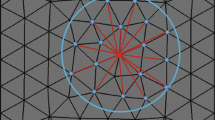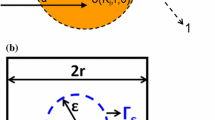Abstract
The fidelity of the peridynamic theory in predicting fracture is investigated through a comparative study. Peridynamic predictions for fracture propagation paths and speeds are compared against various experimental observations. Furthermore, these predictions are compared to the previous predictions from extended finite elements (XFEM) and the cohesive zone model (CZM). Three different fracture experiments are modeled using peridynamics: two experimental benchmark dynamic fracture problems and one experimental crack growth study involving the impact of a matrix plate with a stiff embedded inclusion. In all cases, it is found that the peridynamic simulations capture fracture paths, including branching and microbranching that are in agreement with experimental observations. Crack speeds computed from the peridynamic simulation are on the same order as those of XFEM and CZM simulations. It is concluded that the peridynamic theory is a suitable analysis method for dynamic fracture problems involving multiple cracks with complex branching patterns.
Similar content being viewed by others
Abbreviations
- XFEM:
-
Extended finite elements
- CZM:
-
Cohesive zone model
References
Barenblatt GI (1959) The formation of equilibrium cracks during brittle fracture. general ideas and hypotheses. axially-symmetric cracks. J Appl Math Mech 23(3): 622–636
Belytschko T, Black T (1999) Elastic crack growth in finite elements with minimal remeshing. Int J Numer Methods Eng 45(5): 601–620
Belytschko T, Chen H, Xu J, Zi G (2003) Dynamic crack propagation based on loss of hyperbolicity and a new discontinuous enrichment. Int J Numer Methods Eng 58(12): 1873–1905
Camacho GT, Ortiz M (1996) Computational modelling of impact damage in brittle materials. Int J Solids Struct 33(20-22): 2899–2938
Chandra N, Li H, Shet C et al (2002) Some issues in the application of cohesive zone models for metal-ceramic interfaces. Int J Solids Struct 39(10): 2827–2855
Colavito KW, Kilic B, Celik E, Madenci E, Askari E, Silling S (2007) Effect of nano particles on stiffness and impact strength of composites. In: Proceedings of 48th AIAA/ASME/ASCE/AHS/ASC structures, structural dynamics, and materials conference, Honolulu, Hawaii number AIAA 2007-2071 American Institute of Aeronautics and Astronautics
Cox BN, Gao H, Gross D, Rittel D (2005) Modern topics and challenges in dynamic fracture. J Mech Phys Solids 53(3): 565–596
Fineberg J, Marder M (1999) Instability in dynamic fracture. Phys Reports-Rev Sect Phys Lett 313(1–2): 2–108
Fineberg J, Gross SP, Marder M et al (1992) Instability in the propagation of fast cracks. Phys Rev B 45(10): 5146–5154
Ha YD, Bobaru F (2010) Studies of dynamic crack propagation and crack branching with peridynamics. Int J Fract 162(1–2): 229–244
Ha YD, Bobaru F (2011) Characteristics of dynamic brittle fracture captured with peridynamics. Eng Fract Mech 78: 1156–1168
Kitey R, Tippur HV (2008) Dynamic crack growth past a stiff inclusion: Optical investigation of inclusion eccentricity and inclusion-matrix adhesion strength. Exp Mech 48(1): 37–53
Kitey R, Phan AV, Tippur HV, Kaplan T (2006) Modeling of crack growth through particulate clusters in brittle matrix by symmetric-galerkin boundary element method. Int J Fract 141(1–2): 11–25
Klein PA, Foulk JW, Chen EP, Wimmer SA, Gao HJ (2001) Physics-based modeling of brittle fracture: cohesive formulations and the application of meshfree methods. Theor Appl Fract Mech 37(1–3): 99–166
Moes N, Belytschko T (2002) Extended finite element method for cohesive crack growth. Eng Fract Mech 69(7): 813–833
Moes N, Dolbow J, Belytschko T (1999) A finite element method for crack growth without remeshing. Int J Numer Methods Eng 46(1): 131–150
Ramulu M, Kobayashi AS (1985) Mechanics of crack curving and branching—a dynamic fracture analysis. Int J Fract 27: 187–201
Ravi-Chandar K (1998) Dynamic fracture of nominally brittle materials. Int J Fract 90(1–2): 83–102
Ravi-Chandar K, Knauss WG (1984) An experimental investigation into dynamic fracture.1. crack initiation and arrest. Int J Fract 25(4): 247–262
Ravi-Chandar K, Knauss WG (1984) An experimental investigation into dynamic fracture.2. microstructural aspects. Int J Fract 26(1): 65–80
Ravi-Chandar K, Knauss WG (1984) An experimental investigation into dynamic fracture.3. on steady-state crack-propagation and crack branching. Int J Fract 26(2): 141–154
Sharon E, Fineberg J (1996) Microbranching instability and the dynamic fracture of brittle materials. Phys Rev B 54(10): 7128–7139
Sharon E, Fineberg J (1999) Confirming the continuum theory of dynamic brittle fracture for fast cracks. Nature 397(6717): 333–335
Sharon E, Gross SP, Fineberg J (1995) Local crack branching as a mechanism for instability in dynamic fracture. Phys Rev Lett 74(25): 5096–5099
Silling SA (2000) Reformulation of elasticity theory for discontinuities and long-range forces. J Mech Phys Solids 48(1): 175–209
Silling SA (2003) Dynamic fracture modeling with a meshfree peridynamic code. In: Bathe KJ (eds) Computational fluid and solid mechanics 2003. Elsevier Science Ltd, Oxford, pp 641–644
Silling SA, Askari E (2005) A meshfree method based on the peridynamic model of solid mechanics. Comput Struct 83(17-18): 1526–1535
Song J, Belytschko T (2009) Cracking node method for dynamic fracture with finite elements. Int J Numer Methods Eng 77(3): 360–385
Song J, Wang H, Belytschko T (2008) A comparative study on finite element methods for dynamic fracture. Comput Mech 42(2): 239–250
Xu X, Needleman A (1994) Numerical simulations of fast crack growth in brittle solids. J Mech Phys Solids 42(9): 1397–1434
Author information
Authors and Affiliations
Corresponding author
Rights and permissions
About this article
Cite this article
Agwai, A., Guven, I. & Madenci, E. Predicting crack propagation with peridynamics: a comparative study. Int J Fract 171, 65–78 (2011). https://doi.org/10.1007/s10704-011-9628-4
Received:
Accepted:
Published:
Issue Date:
DOI: https://doi.org/10.1007/s10704-011-9628-4




